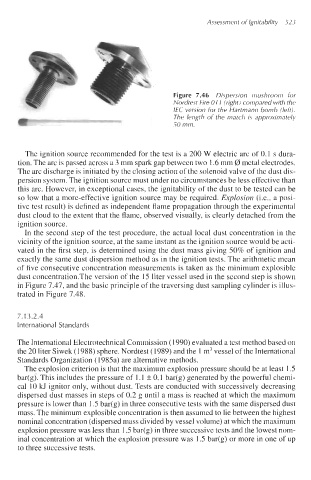Page 556 - Dust Explosions in the Process Industries
P. 556
Assessment of lgnitability 523
Figure 7.46 Dispersion mushroom for
Nordtest Fire 0 1 1 (right) compared with the
IEC version for the Hartmann bomb (left).
The length of the match is approximately
50 mm.
The ignition source recommended for the test is a 200 W electric arc of 0.1 s dura-
tion. The arc is passed across a 3 mm spark gap between two l .6 mm 0 metal electrodes.
The arc discharge is initiated by the closing action of the solenoid valve of the dust dis-
persion system. The ignition source must under no circumstances be less effective than
this arc. However, in exceptional cases, the ignitability of the dust to be tested can be
so low that a more-effective ignition source may be required. Explosion @e., a posi-
tive test result) is defined as independent flame propagation through the experimental
dust cloud to the extent that the flame, observed visually, is clearly detached from the
ignition source.
In the second step of the test procedure, the actual local dust concentration in the
vicinity of the ignition source, at the same instant as the ignition source would be acti-
vated in the first step, is determined using the dust mass giving 50% of ignition and
exactly the same dust dispersion method as in the ignition tests. The arithmetic mean
of five consecutive concentration measurements is taken as the minimum explosible
dust concentration.The version of the 15 liter vessel used in the second step is shown
in Figure 7.47, and the basic principle of the traversing dust sampling cylinder is illus-
trated in Figure 7.48.
7.1 3.2.4
International Standards
The International Electrotechnical Commission (1990) evaluated a test method based on
the 20 liter Siwek (1988) sphere. Nordtest (1989) and the 1 m3 vessel of the International
Standards Organization (1985a) are alternative methods.
The explosion criterion is that the maximum explosion pressure should be at least 1.5
bar(g). This includes the pressure of 1.1 f 0.1 bar(g) generated by the powerful chemi-
cal 10 kJ ignitor only, without dust. Tests are conducted with successively decreasing
dispersed dust masses in steps of 0.2 g until a mass is reached at which the maximum
pressure is lower than 1.5 bar(g) in three consecutive tests with the same dispersed dust
mass. The minimum explosible concentration is then assumed to lie between the highest
nominal concentration (dispersed mass divided by vessel volume) at which the maximum
explosion pressure was less than 1.5 bar(g) in three successive tests and the lowest nom-
inal concentration at which the explosion pressure was 1.5 bar(g) or more in one of up
to three successive tests.

